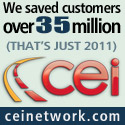
| Monday, January 23, 2012 | Archives | Advertise | Online Buyer's Guide | FLEETSolutions |
U.S. Consumers Don't Support NTSB's Recommendation To Ban Use Of Hands-Free Devices While Driving
In late 2011 the National Transportation Safety Board (NTSB) recommended a ban be put in place on hands-free communication devices that are not completely built-in to a vehicle, to help reduce the number of serious automotive accidents. While a majority of consumers are either "extremely" (sixty-four percent) or "somewhat concerned" (thirty percent) about distracted drivers, fifty-seven percent of consumers do not feel that hands-free devices in a vehicle should be made illegal, according to the study. Yet many consumers are not frequent users of hands-free devices in vehicles, suggesting that the consumers want to make their own choices. The study shows that sixty-eight percent of consumers don't use hands-free devices in vehicles "very often." Fifteen percent of consumers use hands-free devices "somewhat often" while eleven percent use them "very often." "The NTSB's recommendation really brought this issue to the forefront for American consumers and technology providers," said Bryan Krulikowski, Morpace Vice President of Technology and Automotive. "It's clear that consumers have become used to hands-free devices and want to have the right to use them," Krulikowski added. If there is a Federal, State, or local ban on stand-alone hands-free devices, many American consumers would not be dissuaded from purchasing a vehicle that has a built-in, hands-free communications system, according to the findings. Forty percent of consumers would be "extremely" or "somewhat likely" to consider such a vehicle if this new law is put in place. A total of twenty-four percent of consumers would be "extremely" or "somewhat unlikely" to do so and thirty-six percent are undecided. A total of 1,000 consumers were surveyed December 19-27, 2011 as part of the study. |
 |
NAFA Fleet Management Association 125 Village Blvd., Suite 200 Princeton, NJ 08540 Telephone: 609.720.0882 Fax: 609.452.8004 |







